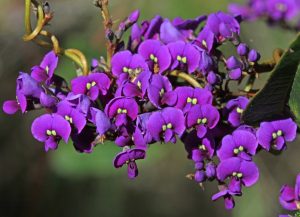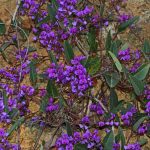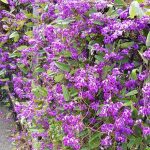Gardening with Indigenous Plants
Indigenous Plant Use
Identification & Control of Common Weeds
| Botanical Name: | Hardenbergia violacea synonym: Glycine violacea |
| Common Name: | false sarsaparilla, native sarsaparilla, purple coral pea, sarsparilla vine |
| Sold As: | Tube ($2.00) |
| Plant Type(s): | Ground Cover (up to 30 cm), Climber / Scrambler / Creeper, Bee Attracting, Butterfly Attracting, Insect Attracting, Popular (home), Popular (bulk), Nature Strip, Cottage, Indigenous Plant Use |
| Indigenous Plant Use: | To make a tea, the leaves need to be initially boiled, then dried.CAUTION: Many plants are poisonous if not collected and prepared properly! |
| Growing Conditions: | Full Sun, Partial Shade
Sandy, Clay, Infertile, Dry, Moist, Well Drained |
| Size (HxW): | 2-6 m x 2-3 m |
| Foliage: | The leaves are dark, glossy green with prominent veins and are 75-100 mm in length. |
| Flowers: | July-November, the flowers, which appear in winter and spring, are usually violet in colour but pink, white and other colours are sometimes found. The flowers are the typical “pea” shape consisting of 4 petals. |
| General Comments: | It is usually a climbing plant whose branches twist around the stems of other plants. It is moderately vigorous but rarely covers other plants so extensively as to cause damage. It grows low to around 3 metres wide, and the dense habit smothers weeds once established. The plant fixes nitrogen from the air, which is good for the soil. |
 Further Information: | |
| Plant Propagation: | 1. Propagation is easy from seed following pre-treatment to break the physical dormancy provided by the impervious seed coat. Pre-treatment can be carried out by abrasion or by the use of boiling water (further details can be found in under the “Propagation” tab of the “Pea Family” page). The seed retains viability for many years. Cuttings strike well using firm, current season’s growth. 2. Sow seed in the warm months of the year. The seed has a hard coating, and needs soaking overnight to soften it. Put boiling water into a container, then put seeds in the water and let it cool down naturally. Plant the next day into seed raising mix, only just covering the seed with soil, keep moist but not wet until germination, which should be in 1 to 3 weeks. 3. Propagation Method: Seed, Softwood cutting, Semi-hardwood cutting |






